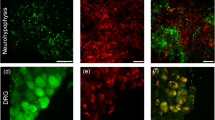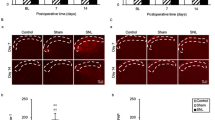Abstract
The synthetic polyribonucleotide pyrogen Poly I : Poly C (800 μg · kg−1) was injected intramuscularly on alternate days into pregnant and non-pregnant female guinea pigs. Pregnant animals, close to term, had smaller fevers in response to the pyrogen than did non-pregnant animals. Repeated injections of the pyrogen caused sequentially smaller fevers for the first 3–4 injections, particularly in non-pregnant animals, and this appeared to be like the tolerance usually developed to repeated injections of endotoxin. Continued pyrogen injections then caused, in non-pregnant animals, fevers of increasing magnitude until the original fever levels were reached, whereas in pregnant guinea pigs the fever responses remained reduced until parturition. The development of tolerance was associated with an increase in immunoreactivity for arginine vasopressin (AVP) in some neurons in the medial part of the paraventricular nucleus, and in terminals in the lateral septum and amygdala similar to changes found in these areas at term of pregnancy. These observations raise the possibility that AVP in these regions may have a role in the development of tolerance to pyrogens, and further quantitative studies of the AVP content of, and release from, nerve terminals projecting to the limbic system seem warranted.
Similar content being viewed by others
References
Absher M, Stinernbring WR (1969) Endotoxin-like properties of Poly I: Poly C an interferon stimulator. Nature 223:715–717
Bocci V, Paulesu L, Ricci MG (1985) The physiological interferon response. IV. Production of interferon by the perfused human placenta at term. Proc Soc Exp Biol Med 180:137–143
Braude AI, Zalesky M, Douglas H (1958) The mechanism of tolerance to fever. J Clin Invest 37:880
Cooper KE (1987) The neurobiology of fever: thoughts on recent developments. Annu Rev neurosci 10:297–324
Cooper KE, Cranston WI (1963) Clearance of radioactive bacterial pyrogen from the circulation. J Physiol (Lond) 166:41–42P
Cooper KE, Kasting NW, Lederis K, Veale WL (1979) Evidence supporting a role for endogenous vasopressin in natural suppression of fever in the sheep. J Physiol (Lond) 295:33–45
Cooper KE, Naylor AM, Veale WL (1987) Evidence supporting a role for endogenous vasopressin in fever suppression in the rat. J Physiol (Lond) 387:163–172
Dinarello CA, Wolff SM (1982) Exogenous pyrogens. In: Milton AS (ed) Pyretics and antipyretics. Springer, Berlin Heidelberg New York, pp 73–112
Dinarello CA, Bernheim HA, Duff GW, Le HV, Nagabhushan TL, Hamilton NC, Coceani F (1984) Mechanisms of fever induced by recombinant human interferon. J Clin Invest 74:906–913
Gander GW, Goodale F (1973) Studies of the endogenous pyrogen released in response to Poly I: Poly C. In: Schönbaum E, Lomax P (eds) The pharmacology of the thermoregulation. Karger, Basel New York, pp 255–263
Gander GW, Goodale F (1975) The role of granulocytes and mononuclear leucocytes in fever. In: Lomax P, Schönbaum E, Jacob J (eds) Temperature regulation and drug action. Karger, Basel New York, pp 51–58
Kasting NW (1980) An antipyretic system in the brain and the role of vasopressin. Ph D thesis, University of Calgary
Kasting NW, Cooper KE, Veale WL (1978) Evidence for a centrally active endogenous antipyretic near parturition. In: Veale WL, Lederis K (eds) Current studies of hypothalamic function. Karger, Basel New York, pp 63–71
Merker G, Blähser S, Zeisberger E (1980) Reactivity pattern of vasopressin-containing neurons and its relation to the antipyretic reaction in the pregnant guinea pig. Cell Tissue Res 212:47–61
Rowley D, Howard JG, Jenkin CR (1956) The fate of32P-labeled bacterial lipopolysaccharide in laboratory animals. Lancet 1:366–367
Zeisberger E, Merker G, Blähser S (1981) Fever response in the guinea-pig before and after parturition. Brain Res 212:379–392
Zeisberger E, Merker G, Blähser S, Krannig M (1986) Role of vasopressin in fever regulation In: Cooper K, Lomax P, Schönbaum E, Veale WL (eds) Homeostasis and thermal stress. Karger, Basel New York, pp 62–65
Author information
Authors and Affiliations
Rights and permissions
About this article
Cite this article
Cooper, K.E., Blähser, S., Malkinson, T.J. et al. Changes in body temperature and vasopressin content of brain neurons, in pregnant and non-pregnant guinea pigs, during fevers produced by Poly I : Poly C. Pflugers Arch. 412, 292–296 (1988). https://doi.org/10.1007/BF00582511
Received:
Revised:
Accepted:
Issue Date:
DOI: https://doi.org/10.1007/BF00582511




